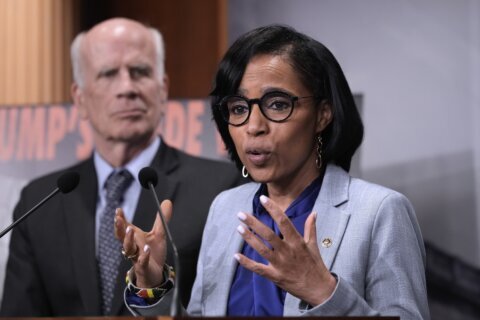This article was republished with permission from WTOP’s news partners at Maryland Matters. Sign up for Maryland Matters’ free email subscription today.
No cases of avian flu have been reported in Maryland this year, but recent reports of two incidents of cattle-to-human transmission of the disease have health and agriculture officials in the state on alert.
“It goes back to prevention. The goal is to not have this infection in Maryland,” said Maryland Agriculture Secretary Kevin Atticks, who said his agency is monitoring the situation closely. “In terms of the poultry industry, we’ve been lucky this year to not have any infections and viral spreads.”
The Centers for Disease Control and Prevention said Friday that federal health officials are “preparing for the possibility of increased risk to human health,” after reports of cattle-to-human infections in Texas in April and in Michigan last week.
Maryland poultry farmers routinely take health and security precautions to protect their flocks from the H5N1 virus, commonly known as bird or avian flu. While the potential risk to human health remains unclear, Maryland’s chicken farms are being urged to maintain biosecurity measures to keep the disease from threatening one of the state’s main agricultural industries.
As the name implies, avian or bird flu is typically found in birds, though there have been cases identified in mammals as well. In April, the first cases of H5N1 were found in herds of cattle across the United States, raising flags for public health officials.
“That has everybody a little heightened and aware,” Atticks said.
In April, a human case of bird flu was believed to be tied to exposure from dairy cows in Texas, one of several dealing with an outbreak of avian flu among cattle. In response, Atticks issued an order restricting the movement of cattle from states with “confirmed detection” of avian flu, except under certain conditions.
On Wednesday, the CDC announced a second case of a human who appeared to catch avian flu from exposure to dairy cows in Michigan. So far, both human cases have been mild, with eye infections the only reported symptom from the virus.
The CDC is enhancing surveillance efforts over the summer to track the transmission of avian flu and see if any mutations in the virus might pose a larger threat for humans.
“Importantly, the risk to the public might change based on whether a (H5N1) viruses acquire genetic changes that increase their transmissibility to and among humans, which could increase the risk of an influenza pandemic,” the CDC said Friday in its Morbidity and Mortality Weekly Report.
Currently, the CDC says the risk for the general public remains “low.” Consuming chicken meat or beef, or drinking pasteurized milk should not pose a great threat to humans, but the CDC recommends that people avoid consuming “raw” unpasteurized milk.
The agency is urging those who regularly come into contact with chicken and cattle to adhere to enhanced biosecurity measures.
Maryland poultry industry
While much of recent news coverage deals with the novel cattle and human cases, poultry farmers will need to continue to monitor for avian flu for the health of their flocks, said Delmarva Chicken Association Executive Director Holly Porter.
“This is definitely an important topic for us. Especially for the livelihood of our farmers in Maryland. The economic impact of the Eastern Shore in Maryland is very much driven around the chicken community,” Porter said.
The association represents five poultry companies in Delmarva — Tyson Foods, Perdue Farms, Mountaire Farms, Amick Farms and Allen Harim Foods — as well as their contract farmers.
In 2022, Maryland chicken farmers raised some 269.2 million chickens for meat production valued at nearly $1.5 billion, according to state data.
Sen. Johnny Mautz (R-Middle Shore) said outbreaks of avian flu can be “devastating” for poultry farmers.
“It’s a painful process. They don’t want to see their flocks harmed,” Mautz said.
When a flock is hit by avian flu, the virus can spread rapidly and has a high mortality rate among the chickens.
“Within hours, you can have half of a chicken house of birds die,” Porter said.
If lab tests confirm avian flu on a commercial farm all of the chickens exposed to the virus must be “depopulated,” or euthanized, and then the farm needs to be decontaminated before it can operate again, according to Porter.
“That’s for two reasons. One, you don’t want the virus to spread. But it’s also for the humane welfare for the birds that are remaining,” she said. “It spreads quickly, it makes the birds sick, and ultimately they are going to die, unfortunately. So for humane purposes we want to go ahead and do that rather than make the bird suffer through the virus itself.”
Porter said the entire process of decontaminating a farm of avian flu can take three to six months.
“Our chicken community have been dealing with avian influenza for years. It’s always a cause for concern,” she said.
Atticks said that people with backyard farms should also keep biosecurity measures up and monitor their smaller flocks to see if their chickens show signs of bird flu. He also said it’s important to ensure backyard flocks do not come into contact with wild birds, the primary way the virus spreads to domestic chickens, and ensure that there are cleanliness protocols in place.
“That you’re engaging in biosecurity measures when dealing with the bird, knowing that this is a virus that is transmissible,” he said. “Wearing a mask, wearing gloves. When you’re handling waste, washing your hands. Maybe having a separate pair of shoes and not tracking, potentially, waste in and out of your chicken area.”
While farmers need to be alert, Atticks said consumers should not be concerned for now.
“The food system, we’re comfortable saying, is safe,” Atticks said. “It is really about the animals getting sick, and then the animal being a vector or spreading it.”







